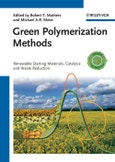Designing polymers and developing polymerization processes that are safe, prevent pollution, and are more efficient in the use of materials and engergy is an important topic in modern chemistry. Today, green polymer research can be seen increasingly in academia nd industry. It tackles all aspects of polymers and polymerization - everything from chemical feedstocks, synthetic pathways, and reaction media to the nature of the final polymer as related to its inherent nontoxicity or degradability. This book summarizes and evaluates the latest developments in green polymerization methods. Specifically, new catalytic methods and processes which incorporate renewable resources will be discussed by leading experts in the field of polymer chemistry. This book is a must-have for Polymer Chemists, Chemists Working with/on Organometallics, Biochemists, Physical Chemists, Chemical Engineers, Biotechnologists, Materials Scientists, and Catalytic Chemists.
Table of Contents
PART I: IntroductionWHY ARE GREEN POLYMERIZATION METHODS RELEVANT TO SOCIETY, INDUSTRY, AND ACADEMICS?
Status and Outlook for Environmentally Benign Processes
Importance of Catalysis
Brief Summaries of Contributions
PART II: Integration of Renewable Starting Materials
PLANT OILS AS RENEWABLE FEEDSTOCK FOR POLYMER SCIENCE
Introduction
Cross-Linked Materials
Non-Cross-Linked Polymers
Conclusion
FURANS AS OFFSPRINGS OF SUGARS AND POLYSACCHARIDES AND PROGENITORS OF AN EMBLEMATIC FAMILY OF POLYMER SIBLINGS
Introduction
First Generation Furans and their Conversion into Monomers
Polymers from Furfuryl Alcohol
Conjugated Polymers and Oligomers
Polyesters
Polyamides
Polyurethanes
Furyl Oxirane
Application of the Diels-Alder Reaction to Furan Polymers
Conclusions
SELECTIVE CONVERSION OF GLYCEROL INTO FUNCTIONAL MONOMERS VIA CATALYTIC PROCESSES
Introduction
Conversion of Glycerol into Glycerol Carbonate
Conversion of Glycerol into Acrolein/Acrylic Acid
Conversion of Glycerol into Glycidol
Oxidation of Glycerol to Functional Carboxylic Acid
Conversion of Glycerol into Acrylonitrile
Selective Conversion of Glycerol into Propylene Glycol
Selective Coupling of Glycerol with Functional Monomers
Conclusion
PART III: Sustainable Reaction Conditions
MONOTERPENES AS POLYMERIZATION SOLVENTS AND MONOMERS IN POLYMER CHEMISTRY
Introduction
Monoterpenes as Monomers
Monoterpenes as Solvents and Chain Transfer Agents
Conclusion
CONTROLLED AND LIVING POLYMERIZATION IN WATER: MODERN METHODS AND APPLICATION TO BIO-SYNTHETIC HYBRID MATERIALS
Introduction
Ring-Opening Metathesis Polymerization (ROMP)
Living Free Radical Methods for Bio-Synthetic Hybrid Materials
TOWARDS SUSTAINABLE SOLUTION POLYMERIZATION: BIODIESEL AS A POLYMERIZATION SOLVENT
Introduction
Solution Polymerization and Green Solvents
Biodiesel as a Polymerization Solvent
Experimental Section
Effect of FAME Solvent on Polymerization Kinetics
Effect of Biodiesel Feedstock
Conclusion
PART IV: Catalytic Processes
RING-OPENING POLYMERIZATION OF RENEWABLE SIX-MEMBERED CYCLIC CARBONATES. MONOMER SYNTHESIS AND CATALYSIS
Introduction
Preparation of 1,3-Propanediol from Renewable Resources
Preparation of Dimethylcarbonate from Renewable Resources
Synthesis of Trimethylene Carbonate
Six-Membered Cyclic Carbonates: Thermodynamic Properties of Ring-Opening Polymerization
Catalytic Processes Using Green Catalysts Methods
Thermoplastic Elastomers and their Biodegradation Processes
Concluding Remarks
POLY(LACTIDE)S AS ROBUST RENEWABLE MATERIALS
Introduction
Ring-Opening Polymerization of Lactide
Poly(lactide) Properties
Thermoplastic Elastomers
Future Developments/Outlook
SYNTHESIS OF SACCHARIDE-DERIVED FUNCTIONAL POLYMERS
Introduction
Polyethers
Polyamides
Polyurethanes and Polyureas
Glycosilicones
DEGRADABLE AND BIODEGRADABLE POLYMERS BY CONTROLLED/LIVING RADICAL POLYMERIZATION: FROM SYNTHESIS TO APPLICATION
Introduction
(Bio)degradable Polymers by CRP
Conclusions
PART V: Biomimetic Methods and Biocatalysis
HIGH-PERFORMANCE POLYMERS FROM PHENOLIC BIOMONOMERS
Introduction
Coumarates as Phytomonomers
LC Properties of Homopolymers
LC Copolymers for Biomaterials
LC Copolymers for Photofunctional Polymers
LC Copolymers for High Heat-Resistant Polymers
Conclusion
ENZYMATIC POLYMER SYNTHESIS IN GREEN CHEMISTRY
Introduction
Polymers
Green Media for Enzymatic Polymerization
Conclusions and Outlook
GREEN CATIONIC POLYMERIZATIONS AND POLYMER FUNCTIONALIZATION FOR BIOTECHNOLOGY
Introduction
Enzyme Catalysis
"Green" Cationic Polymerizations and Polymer Functionalization Using Lipases
Natural Rubber Biosynthesis -
The Ultimate Green Cationic Polymerization
Green Synthetic Cationic Polymerization and Copolymerization of Isoprene








